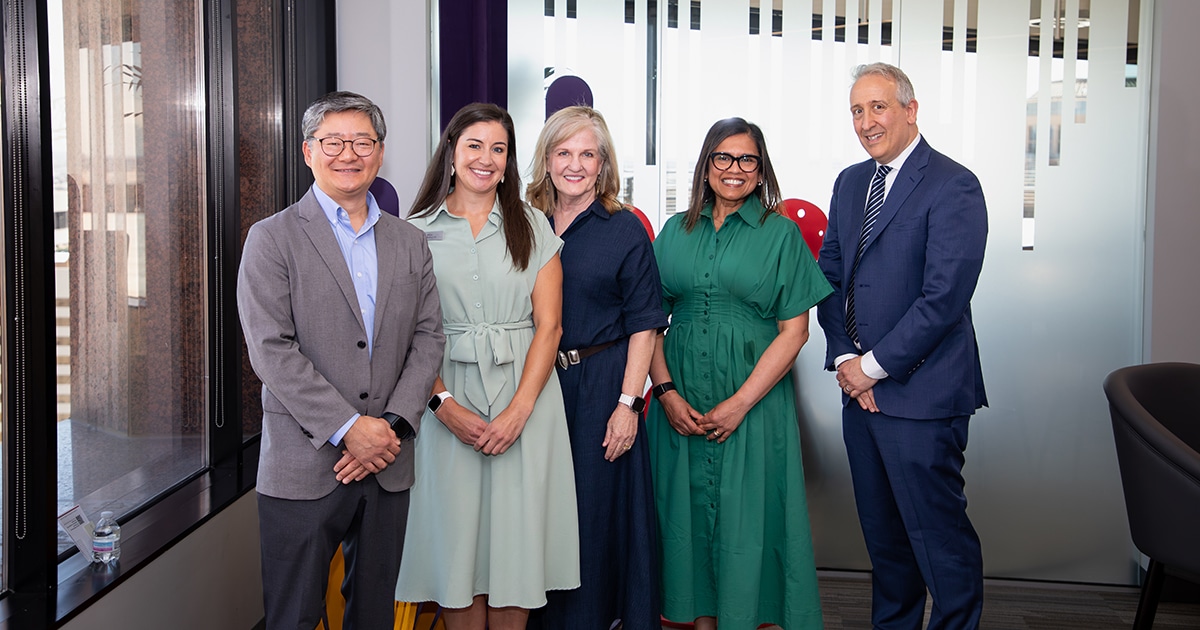

Ambassador Event: Future of Healthcare Innovation and the Biosciences
Published: 07/02/2025
Panel discusses growth opportunities for Greater Phoenix’s healthcare innovation and bioscience ecosystems
The growth of Greater Phoenix’s healthcare innovation and bioscience ecosystems has been spurred by a variety of components: alignment with the semiconductor industry, the number of legacy healthcare institutes conducting clinical trials and offering collaboration opportunities, a talented and growing workforce, and more.
There’s more work to be done, though, to continue building the region’s bioscience and healthcare innovation clusters and maximize funding and resilience.
The Greater Phoenix Economic Council (GPEC) hosted an Ambassador Event to discuss the ecosystem with a panel of regional experts. The panel consisted of:
- Dr. Corey Casper, Chief Research Officer, Banner Health
- Dr. Manoja Lecamwasam, System Vice President, Intellectual Property and Life Sciences Innovation, CommonSpirit Health
- Tammy McLeod, CEO, Flinn Foundation
- Chris Yoo, General Partner & Managing Director, XCellerant Ventures
- Allie Bakovic, Vice President, Bioscience Business Development, GPEC (Moderator)
“This region is poised for exceptional growth, and I see things here that are necessary for the growth of biotech and successful product development that I see in very few other places in the country right now,” Casper said.
Alignment between semiconductors and healthcare innovation
Greater Phoenix’s rise to national prominence in the medtech sector has aligned with the growth of the semiconductor industry. There is a close relationship between chip producers and medical device developers, driven by the cluster established in the region.
The number of medtech and biomanufacturing jobs in Greater Phoenix has increased nearly 2.5 times since 2015, well ahead of global nexuses like Boston and San Diego. The employed labor force is made of nearly 12,000 individuals, a top-15 figure in the country as of 2024.
The relationship between these businesses and the semiconductor companies is reflected in trade, in which medical manufacturers in Greater Phoenix made 88% of their purchases from local semiconductor and printed circuit assembly industries. This, along with research and development, offers an ecosystem conducive for wearables, monitoring and intervention.
“There’s a natural convergence of technology,” Yoo said.
There are expansive efforts to build upon this cluster. The GPEC-led Medical Device Manufacturing Multiplier (MDM2) Consortium, a 25-member consortium of private, public and educational institutions funded in part by the Tech Hubs program under the Economic Development Administration, bolsters the medtech industry with a vision of establishing a sustainable, globally competitive ecosystem.
“It is an attempt to bring together the Medtronics, Strykers, BD, Abbotts of world with Intel and TSMC and others that build technology,” Yoo said. “As we wear more of these wearables, it’s all going to be about miniaturization and getting the costs down so that those therapies will be affordable.”
Ensuring providers are in the loop
As companies leverage the strengths of Greater Phoenix to develop health-related technologies, they must work alongside the health providers to ensure cost and reimbursement of care are considered in the process of tech development, cautioned Manoja.
“As you start to build on these ecosystems and collaborations, you have to keep the provider in the center of all that,” she said. “If these things don’t go to the physician or the clinician and doesn’t get prescribed to the patient, there’s a bottleneck and none of these technologies can work.”
Greater Phoenix’s medical sector, which includes major providers like Banner Health, Dignity Health, HonorHeath, CommonSpirit and Mayo Clinic, is among the most reliable in the country and bolstered by a talent pipeline that includes more than 2,500 medical students enrolled in the state.
Arizona also offers the eighth-most clinical trials in the country despite having the 14th-largest population. With a large, diverse population and the comprehensive base of hospitals and medical schools, the state offers advantages, but the panel said there are ways to maximize the effectiveness of the trials, focusing on technological advancement and product-based results.
“We need to strengthen recruitment, and that starts with stories,” said McLeod. She added that patients are 77% more likely to participate if they relate to the story behind a trial, better understanding the benefits and how it can affect them and their community.
By being more effective and efficient with the recruiting, there can be better matching to clinical trials.
“We should [create more medical products] based on the degree of innovation and thought leadership that we have here,” Casper said.
This cycles back to the requisite of more effective, broad collaboration opportunities. In this, leaders can pull ideas from other industries. McLeod mentioned the fintech sandbox, which allows financial technologies to test and validate technologies quickly, as an inspiration for a program that could aid the medical industry. Yoo said hackathon-type events could spur technology.
“It would be tremendous if we could take cross-institutional [partners] — so Mayo, Banner, Dignity, Honor — and put our physicians in rooms with engineers,” Yoo said. “Almost like a hackathon, if you will. Those things would truly, I think, accelerate our ability to find new innovation that starts at the beginning with the end in mind.
By finding unique ways to foster collaboration between the multitude of related parties within the ecosystem, Greater Phoenix can advance its clinical trial, medtech and bioscience spheres.
“Bringing that together would be a differentiator for our state,” McLeod said.
Accessing healthcare and bioscience funding
Discussions of cuts to federal healthcare-related funding, including Medicare, have impacted the broader health innovation and bioscience ecosystems around the nation. Arizona, home to public universities that combined for $300 million in National Institutes of Health and National Science Foundation funding in 2023, would be among the states affected by cuts.
Arizona must evaluate other areas of federal funding, like the Biomedical Advanced Research and Development Authority and the Defense Advanced Research Projects Agency, channel private investment and philanthropy, and replicate successful movements in other states that have advanced medical innovation locally.
As Casper said: “Never waste a good crisis.”
“If we find a way as a region to invest in research at a time where so many people are withdrawing from it, when this flood recedes, we’ll be in such a great position,” he said.
The domestic market for goods and services in the clinical trial sector is valued between $25 billion to $40 billion. Between 2018-25, Greater Phoenix hospitals announced more than $6 billion in capital investment, which has been used to fund new specialty institutes and translational research facilities. As of May, GPEC’s project pipeline included 10 bioscience companies considering expansion into the region, which represent a potential of more than 2,000 jobs and $10 billion in capital investment.
New avenues to maintain funding would improve health outcomes while creating jobs and spurring further economic growth. Every one bioscience job creates 3.83 indirect jobs, according to Bakovic.
“Healthcare and bioscience infrastructure is economic infrastructure,” Bakovic said.
Meet the Panel
Dr. Corey Casper
Chief Research Officer
Banner Health
Dr. Manoja Lecamwasam
System Vice President, Intellectual Property and Life Sciences Innovation
CommonSpirit Health
Tammy McLeod
CEO
Flinn Foundation
Chris Yoo
General Partner & Managing Director
XCellerant Ventures
Allie Bakovic (Moderator)
Vice President, Bioscience Business Development
Greater Phoenix Economic Council




